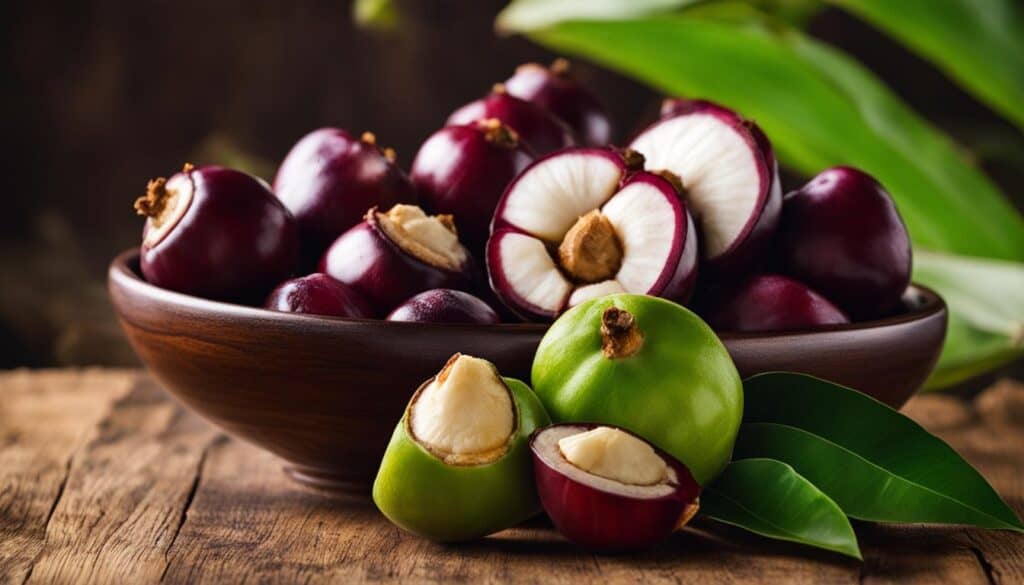Greetings, fellow fruit enthusiasts! Today, I am thrilled to take you on a journey to discover the marvels of the magnificent mangosteen tree. This tropical fruit tree is truly a treasure, not only for its delicious flavor but also for its incredible health benefits and rich cultural heritage. Join me as we explore the cultivation, care, harvesting, and traditional medicinal uses of this exotic tree.
Key Takeaways:
- The mangosteen tree is an exotic and highly prized tropical fruit tree.
- It offers a range of health benefits, including immune system support and potential anti-cancer effects.
- Mangosteen is a versatile culinary ingredient, perfect for fruit salads, smoothies, desserts, and garnishes.
- Traditional medicine has long recognized the healing properties of mangosteen for digestive issues and skin conditions.
- Proper care, including pruning and watering, is crucial for the healthy growth of mangosteen trees.
The Health Benefits of Mangosteen
Mangosteen, a tropical fruit native to Southeast Asia, is not only renowned for its delectable taste but also for its impressive health benefits. This exotic fruit is packed with essential nutrients, vitamins, and potent antioxidants, making it a powerful boost to the immune system. Incorporating mangosteen into our diets can provide a delicious way to reap these health benefits.
Mangosteen contains a wide array of phytochemicals, including xanthones, which are known for their immune-boosting properties. These compounds help strengthen our body’s defense mechanisms, supporting overall immune system function and helping to protect against illnesses.
Furthermore, mangosteen has been found to possess potent anti-inflammatory properties. Chronic inflammation in the body can lead to various health issues, including heart disease, diabetes, and certain types of cancer. Consuming mangosteen regularly may help reduce inflammation and lower the risk of these diseases. Research has also shown that mangosteen may have potential anti-cancer effects, although further studies are needed to fully understand its impact.
“Mangosteen is a tropical treasure that not only tantalizes the taste buds but also provides a myriad of health benefits. Its immune system-supporting properties, anti-inflammatory effects, and potential anti-cancer effects make it a remarkable addition to a well-rounded diet.”
The Health Benefits Summarized:
- Boosts the immune system
- Has anti-inflammatory properties
- May have potential anti-cancer effects
So why not indulge in the tropical delight of mangosteen and enjoy the nourishing benefits it offers?
Taste and Culinary Uses of Mangosteen
The mangosteen, a tropical fruit from the mangosteen tree, offers a unique and delightful taste that enhances various culinary creations. Its combination of sweetness and tanginess makes it an excellent addition to fruit salads, refreshing smoothies, and decadent desserts. The versatility of the mangosteen extends even further, as it can also be used as a beautiful garnish to add a touch of elegance to any dish.
When incorporated into fruit salads, the vibrant purple rind of the mangosteen creates a visually stunning presentation. The juicy white segments inside provide a burst of flavor that pairs well with other tropical fruits like pineapple and mango. In smoothies, the mangosteen adds a refreshing and tropical twist, providing a natural sweetness that harmonizes with other ingredients. For those with a sweet tooth, mangosteen can transform desserts into a delectable culinary experience. Whether it’s used in cakes, pies, or ice creams, the creamy texture and unique taste of the mangosteen elevate any sweet treat.
Not only does the mangosteen enhance the taste of culinary creations, but it also adds a touch of elegance as a garnish. Whether it’s placed atop a cocktail, salad, or main course, the vibrant purple hue of the rind and the delicate white flesh of the fruit create a visually appealing contrast. The presence of mangosteen as a garnish elevates the overall presentation of a dish, making it visually enticing and inviting.
The Traditional and Medicinal Uses of Mangosteen

Mangosteen, a tropical fruit from the mangosteen tree, has a rich history of use in traditional medicine. Its healing properties have been utilized for centuries to address various health issues, including digestive problems and skin conditions. The fruit’s high antioxidant content is believed to contribute to its medicinal benefits, making it a valuable addition to alternative healing practices.
In traditional medicine, mangosteen has been commonly used to alleviate digestive issues such as diarrhea, dysentery, and stomachaches. The fruit’s natural compounds are believed to soothe the stomach and promote healthy digestion. Mangosteen has also been used externally to treat skin conditions like eczema and acne, thanks to its anti-inflammatory properties.
The antioxidant content of mangosteen is another reason for its traditional medicinal uses. Antioxidants help combat oxidative stress and protect the body against free radicals, which can lead to various health problems. By incorporating mangosteen into their diets, people have sought to support their overall well-being and enhance their body’s natural defense mechanisms.
“The mangosteen fruit has a long history of use in traditional medicine, particularly for addressing digestive issues and skin conditions. Its numerous antioxidants make it a popular choice for those seeking natural remedies to support their overall health.”
Traditional Uses of Mangosteen:
- Alleviating digestive issues such as diarrhea and stomachaches
- Treating skin conditions like eczema and acne
- Supporting overall well-being through antioxidant properties
While modern research is still ongoing to fully understand the extent of mangosteen’s medicinal benefits, its traditional uses have provided valuable insights into its potential healing properties. As people continue to explore natural remedies, the mangosteen fruit remains a tropical treasure with a rich history in traditional medicine.
Growing and Harvesting Mangosteen
Growing mangosteen trees requires specific conditions and careful attention to detail. These tropical trees thrive in a hot and humid climate, making them perfectly suited for regions with tropical or subtropical climates. The mangosteen tree prefers consistent rainfall, so areas with an average annual rainfall of 50 to 100 inches are ideal. Good drainage is essential, as the roots of the mangosteen tree are sensitive to excess moisture. Partial shade is also preferred, as direct sunlight can be too intense.
When cultivating mangosteen trees, it is important to select a well-drained soil that is rich in organic matter. The soil should have a slightly acidic pH level, ranging from 5.0 to 6.5. Before planting, it is recommended to improve the soil by incorporating compost or well-decomposed organic matter. This will help provide the necessary nutrients for the tree’s healthy growth.
Patience is key when growing mangosteen trees, as it can take up to 10 years for the tree to bear fruit. However, the wait is well worth it, as the sweet and tangy fruits of the mangosteen tree are truly a tropical delight. Harvesting mangosteen fruits should be done carefully by hand-picking the ripe fruits at the right time. Ripe mangosteens have a deep purple rind that yields slightly when pressed. The outer rind is gently removed to reveal the creamy, white segments inside, which are the edible part of the fruit.
Table: Ideal Growing Conditions for Mangosteen Trees
| Climate | Soil | Light | Water |
|---|---|---|---|
| Tropical or subtropical | Well-drained with organic matter | Partial shade | Consistent rainfall |
| Average annual rainfall of 50 to 100 inches | pH level of 5.0 to 6.5 | Protection from intense sunlight | Regular watering and good drainage |
By providing the ideal growing conditions, proper care, and patience, you can enjoy the bountiful harvest of mangosteen fruits from your very own tree. Whether you plan to enjoy the fruits fresh or explore their culinary uses, growing mangosteen trees can be a fulfilling and rewarding experience.
Mangosteen Tree Care
Proper care of the mangosteen tree is crucial for its healthy growth and abundant fruit production. As a tropical tree, it requires specific attention to ensure optimal conditions for thriving. Here are some essential aspects of mangosteen tree care:
Pruning
Regular pruning plays a vital role in maintaining the health and shape of the mangosteen tree. It helps to remove dead or diseased branches, improve air circulation, and encourage new growth. Pruning should be done during the tree’s dormant period to minimize stress. It is essential to use sharp and clean pruning tools to minimize the risk of infection.
Fertilizing
Mangosteen trees benefit from regular fertilization to ensure they receive proper nutrients for optimal growth and fruit production. Use a balanced fertilizer with a ratio of nitrogen, phosphorus, and potassium (NPK) that is suitable for fruit trees. Apply the fertilizer evenly around the base of the tree, avoiding direct contact with the trunk. Fertilizing should be done during the growing season, following the manufacturer’s instructions.
Watering
Mangosteen trees require consistent and adequate watering to maintain their health and vigor. They prefer well-drained soil that is moist but not waterlogged. During the dry season, it may be necessary to water the tree more frequently. However, excessive watering should be avoided, as it can lead to root rot and other problems. Monitoring the soil moisture and adjusting watering accordingly is essential.
Pests and Diseases
Like any other tree, mangosteen trees are susceptible to various pests and diseases. Common pests include aphids, scale insects, and fungal diseases like anthracnose and root rot. Regular inspection of the tree and prompt action at the first sign of pest or disease infestation is crucial. Using organic pest control methods or consulting a professional arborist can help manage and prevent such issues.
Proper care of your mangosteen tree will ensure its long-term health, productivity, and the enjoyment of its delicious fruits. With regular pruning, appropriate fertilization, consistent watering, and proactive pest and disease management, your mangosteen tree will thrive and provide you with a bountiful harvest.
Medicinal Uses of Mangosteen

When it comes to the mangosteen tree, its benefits extend far beyond its delicious taste and culinary uses. This tropical fruit has a long history of being utilized for its medicinal properties and potential contributions to overall well-being.
One of the notable medicinal uses of mangosteen is its positive impact on digestive health. The fruit has been traditionally used to soothe the stomach, address digestive issues, and promote healthy digestion. Its natural compounds aid in reducing inflammation and supporting a healthy gastrointestinal system.
Furthermore, mangosteen is cherished for its potential benefits for skin health. With its high antioxidant content, it is believed to help combat free radicals and reduce oxidative stress, which can contribute to skin aging. Many skincare products include mangosteen as an ingredient due to its rejuvenating and moisturizing properties.
“Mangosteen has shown promise in promoting digestive health, supporting skin health, and contributing to overall well-being.”
When it comes to overall well-being, incorporating mangosteen into your diet can be a wise choice. Its rich nutritional profile, including essential vitamins and potent antioxidants, makes it a great addition to a balanced and wholesome lifestyle. While more research is needed to fully understand the extent of its medicinal properties, the potential benefits of mangosteen are certainly promising.
From digestive health to skin health and overall well-being, mangosteen continues to captivate with its diverse range of medicinal uses. Whether enjoying the fruit fresh or incorporating it into culinary creations, embracing the wonders of the mangosteen tree can be a delightful way to explore the potential benefits it offers.
Mangosteen’s Medicinal Benefits at a Glance:
| Medicinal Benefits | Details |
|---|---|
| Digestive Health | Soothes the stomach, addresses digestive issues, and promotes healthy digestion. |
| Skin Health | Rich antioxidant content helps combat free radicals and supports rejuvenation and moisturization. |
| Overall Well-being | With essential nutrients and potent antioxidants, mangosteen contributes to a balanced and wholesome lifestyle. |
Harvesting and Storing Mangosteen Fruits
Harvesting mangosteen fruits requires precision and care to ensure the best quality. Ripe mangosteens are hand-picked from the tree, with the outer purple rind gently removed to reveal the creamy, white segments inside. This delicate process ensures that the fruit remains intact and undamaged.
The quality of the harvested mangosteen fruits is crucial for their taste and freshness. Only fully ripe fruits should be selected, as they offer the perfect balance of sweetness and tanginess. It is important to visually inspect each fruit, ensuring it has a firm texture and vibrant color.
To maintain the freshness of mangosteens, they should be stored at cool temperatures. Ideally, they should be consumed immediately after harvesting to enjoy their optimal flavor. If storing is necessary, refrigeration is recommended, as it helps to preserve the fruit’s taste and texture. However, it is best to consume mangosteens as soon as possible to fully experience their delightful flavor.
| Harvesting Techniques | Fruit Quality | Storing | Freshness |
|---|---|---|---|
| Hand-picking ripe fruits | Visually inspecting for firm texture and vibrant color | Refrigeration recommended | Best consumed immediately |
Proper harvesting and careful storage are essential to preserve the taste and quality of mangosteen fruits. By following these techniques, you can fully enjoy the unique flavors and benefits that mangosteens have to offer.
Conclusion
In conclusion, the mangosteen tree is a true tropical treasure. It not only provides delicious fruits but also offers a wide range of health benefits. Incorporating mangosteen into our diets can be a flavorful way to boost our immune system, thanks to its abundance of essential nutrients, vitamins, and antioxidants.
Not only is the mangosteen tree beneficial for our health, but it also adds a delightful touch to various culinary creations. Its unique combination of sweetness and tanginess makes it a versatile ingredient in fruit salads, smoothies, desserts, and even as a decorative garnish.
In addition to its culinary uses, the mangosteen tree has a rich history of traditional medicinal uses. Its properties have been known to aid in digestion, soothe the stomach, and improve overall well-being. The tree’s cultivation may require specific conditions and patience, but the rewards are well worth the effort.
Embracing the wonders of the mangosteen tree allows us to explore its potential in promoting our health and well-being. From its health benefits to its culinary and traditional uses, the mangosteen tree truly stands out in the world of tropical fruits. So let’s savor its delicious fruits and reap the rewards it has to offer.
FAQ
What are the health benefits of mangosteen?
Mangosteen is packed with essential nutrients, vitamins, and potent antioxidants, making it a powerful boost to the immune system. It also has anti-inflammatory properties and has shown potential anti-cancer effects.
How can mangosteen be used in culinary creations?
The unique combination of sweetness and tanginess in mangosteen makes it a delightful addition to various culinary creations. It can be enjoyed fresh, added to fruit salads, incorporated into smoothies and desserts, or used as a garnish.
What are the traditional medicinal uses of mangosteen?
Mangosteen has a long history of use in traditional medicine. It has been used to address digestive issues, soothe the stomach, promote healthy digestion, and provide relief for skin conditions. Its rich antioxidant content has also been associated with overall well-being.
What are the growing conditions and harvesting techniques for mangosteen?
Mangosteen trees thrive in tropical climates with high humidity and consistent rainfall. They prefer well-drained soil and partial shade. Harvesting involves hand-picking the ripe mangosteen fruits at the right time to ensure quality.
How should I take care of my mangosteen tree?
Proper care of the mangosteen tree is essential for its healthy growth and fruit production. This includes regular pruning, appropriate fertilization, consistent watering, and protecting the tree from pests and diseases.
What are the medicinal uses of mangosteen?
In addition to its traditional uses, mangosteen has been studied for its potential benefits in promoting digestive health, supporting skin health, and contributing to overall well-being. Further research is needed to fully understand its medicinal properties.
How should I harvest and store mangosteen fruits?
Harvesting mangosteen fruits requires skill and careful techniques. Ripe fruits are hand-picked to ensure their quality. The outer purple rind is gently removed to reveal the creamy, white segments inside. To maintain freshness, mangosteens are typically stored at cool temperatures or consumed immediately.





Leave a Reply